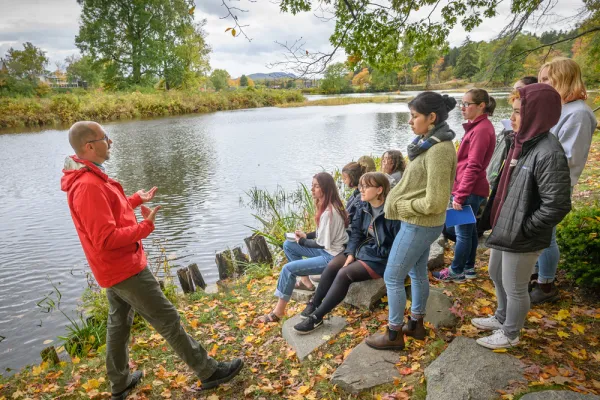Studying Climate Change
Sustainability

Published November 14, 2019
Whether you’re enrolled in a humanities, social sciences, STEM or interdisciplinary course this semester at Smith, chances are your studies have touched on the issue of climate change.
During this first semester of the college’s themed Year on Climate Change, professors from many different disciplines have taken up the challenge of helping students explore the impact of climate change in their fields of study.
“There are over 100 courses being offered across the curriculum this year on issues and topics that relate to climate change,” says Denise McKahn, associate professor of engineering and faculty director of Smith’s Center for the Environment, Ecological Design and Sustainability “And there have been three times the number of curricular enhancement grants given in direct support of the development of climate curriculum.”
Relevant course offerings range from contemporary poetry to green energy policy, so that students of all academic backgrounds can engage in learning about climate change and environmental sustainability.
Assistant professor of environmental science and policy Alex Barron—who regularly teaches classes on environmental sustainability—says he went into the themed year looking forward to “the opportunity for a major in art or the study of women and gender to spend a little more time thinking about climate and how it connects to what’s going on in their discipline.”
Many students are already doing that, Barron adds, “but the opportunity for everyone on campus to discover and explore those connections is really an exciting thing.”
In his classes, Barron organizes small group discussions, where students ask critical questions about issues such as greenhouse gas emissions, and consider the big-picture problem of climate change.
Samikshya Dhami ’22 says she took away from one such discussion that “if one person uses metal straws, it doesn’t reduce the amount of [plastic] straws being produced. But if a place like Smith stops using straws, that can make a bigger difference.”
Liv Colon ’22, who is in Barron’s “Sustainability and Social-Ecological Systems” class, says she is glad to see that “a lot of departments are starting to have climate change as a focus because no matter what your major is, we’re all going to have to live with it.”
Discussions of climate change are also occurring outside of STEM and social science classes.
Joel Kaminsky, Morningstar Professor of Jewish Studies and Professor of Religion, expanded a unit on the Bible and the environment in his first-year seminar this semester. He also invited a guest speaker, The Rev. Anna Woofenden, to talk about her “Christian environmentalist” work as founding pastor of an urban farm/church in California.
“Instead of one week exploring the Bible and the environment, we have had a full two weeks of class dedicated to this topic,” Kaminsky says. “Those extra class meetings meant that the students read a much wider array of essays on this topic. In turn, discussions have been richer and deeper.”
Associate professor Sujane Wu developed her new, advanced-level Chinese language course, “Food for Thought: Chinese Language, Culture, Environment and Health,” with Year on Climate Change goals in mind. Wu takes a make-it-happen approach to the topic, in hopes that her students will “understand that climate change is in each individual’s hands. We cannot and should not always rely on other people to make changes on our behalf.”
Many classes are addressing the complexities of climate change through a social justice lens.
One recent morning, students in lecturer Sara Eddy’s “Colloquia in Writing: Consumer Culture” class were seated in a circle, having a back-and-forth about how consumerism can harm the environment.
Noting that inexpensive brands produced through inhumane labor practices can boost consumerism, Eddy asked, “Is there any way around that?” Students discussed the many facets of the issue, reflecting on the fact that buying inexpensive products may be the only option for people with scarce economic resources.
Some courses offer students the opportunity to step off campus to consider the consequences of human interference with the environment. For example, landscape studies lecturer Reid Bertone-Johnson’s first-year seminar, “Our Mill River,” teaches students about the natural and cultural history of the river through field trips to communities along its banks.
“Studying the river and the ways in which it impacts the communities through which it flows is a wonderful way to think about hyperlocal implications of climate change,” Bertone-Johnson says.
Encouraging such thinking is the goal of the college’s themed year, he adds. “We're living with this reality—that we created,” Bertone-Johnson says, “I hope my students will build a set of critical skills to see and ask questions about their surroundings.”
Landscape studies lecturer Reid Bertone-Johnson's first year seminar about the Mill River is among the many Smith course offerings focusing on climate change.